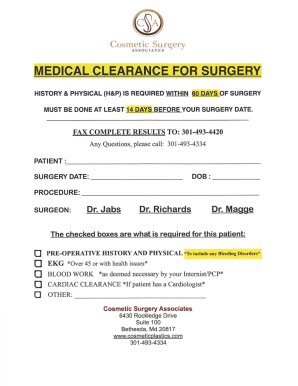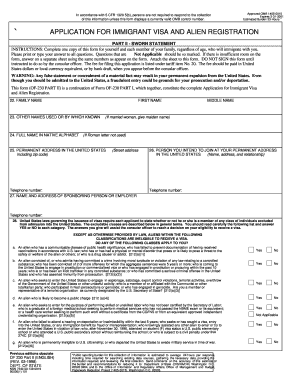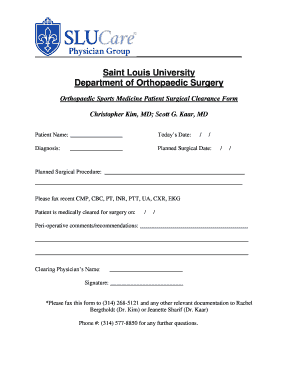
Cosmetic Surgery Associates Medical Clearance for Surgery 2016 free printable template
Show details
MEDICAL CLEARANCE FOR SURGERY PATIENT DOB SURGERY DATE SURGEON COMPREHENSIVE HISTORY AND PHYSICAL BLOOD TESTS DEEMED NECESSARY BY YOUR INTERNIST EKG (OVER 45 OR WITH HEART HEALTH ISSUES) OTHER: NOTE:
pdfFiller is not affiliated with any government organization
Get, Create, Make and Sign medical clearance for surgery form

Edit your medical clearance for surgery form online
Type text, complete fillable fields, insert images, highlight or blackout data for discretion, add comments, and more.

Add your legally-binding signature
Draw or type your signature, upload a signature image, or capture it with your digital camera.

Share your form instantly
Email, fax, or share your medical clearance for surgery form via URL. You can also download, print, or export forms to your preferred cloud storage service.
How to edit medical clearance for surgery online
Follow the steps down below to benefit from a competent PDF editor:
1
Log in to account. Start Free Trial and register a profile if you don't have one.
2
Upload a file. Select Add New on your Dashboard and upload a file from your device or import it from the cloud, online, or internal mail. Then click Edit.
3
Edit medical clearance for surgery. Rearrange and rotate pages, add and edit text, and use additional tools. To save changes and return to your Dashboard, click Done. The Documents tab allows you to merge, divide, lock, or unlock files.
4
Get your file. Select the name of your file in the docs list and choose your preferred exporting method. You can download it as a PDF, save it in another format, send it by email, or transfer it to the cloud.
pdfFiller makes working with documents easier than you could ever imagine. Create an account to find out for yourself how it works!
Cosmetic Surgery Associates Medical Clearance for Surgery Form Versions
Version
Form Popularity
Fillable & printabley
How to fill out medical clearance for surgery

01
To fill out a medical clearance for surgery, you will first need to obtain the necessary forms from your healthcare provider or surgeon. These forms typically ask for basic information such as your name, date of birth, and contact details.
02
The forms will also require you to disclose your medical history, including any pre-existing conditions, allergies, medications you are currently taking, and any previous surgeries or hospitalizations. It is important to provide accurate and detailed information to ensure that your surgeon is fully aware of your medical background.
03
In addition to your medical history, the clearance forms may also ask you to provide information about any recent illnesses or infections, as well as any recent diagnostic tests or imaging studies that you have undergone. It is important to include this information to help your surgeon assess your overall health and determine the safety of the surgery.
04
Depending on the type of surgery you are undergoing, the forms may also ask about lifestyle factors such as smoking or alcohol consumption. These habits can have an impact on your surgical outcome, so it is important to be honest and disclose any relevant information.
05
Once you have completed the medical clearance forms, they will typically need to be reviewed and signed by a healthcare provider. This could be your primary care physician or a specialist, depending on the requirements of your surgeon or hospital. It is important to allow enough time for this review process, as it may take several days.
06
As for who needs medical clearance for surgery, it generally depends on the individual and the specific procedure. In most cases, individuals with underlying health conditions, such as heart disease, diabetes, or respiratory issues, will be required to undergo a medical clearance. Additionally, older adults or individuals with a history of certain conditions may also need to obtain medical clearance before undergoing surgery.
07
Ultimately, the decision to require medical clearance for surgery is made by your surgeon or healthcare team. They will evaluate your overall health and assess any potential risks associated with the surgery. If medical clearance is deemed necessary, it is important to follow through and fulfill these requirements to ensure the best possible surgical outcome.
Fill
form
: Try Risk Free
People Also Ask about
How do I document a preoperative clearance?
History – documentation of the past medical history, a review of current symptoms, a list of medications, allergies, past surgical history and family history. Physical exam – height, weight, vital signs, and documentation of any abnormal findings on exam of the entire body.
How long does it take to get clearance for a surgery?
This checkup is usually held around 1 month before the date your surgery is scheduled. This provides your doctor and surgeon with plenty of time to address any medical issues prior to surgery. The pre-op exam includes a basic physical exam, as well as discussing your health history and current health.
What does surgically cleared mean?
Surgical Clearance is an examination that determines whether a patient is an appropriate candidate for surgery. By performing an examination and running the necessary tests, doctors can ensure that a patient will be able to tolerate the surgery safely and obtain successful results.
What to expect for surgical clearance?
A Pre-surgical clearance exam typically includes a medical history review, physical examination, and laboratory testing. The medical history review assesses the patient's past and current health conditions. The physical examination assesses the patient's current fitness level.
What does medical clearance for surgery entail?
The term is often used by surgeons requesting a medical evaluation before performing surgery on a patient. In the context of surgery, a medical clearance is, essentially, considered to be an authorization from an evaluating clinician that a patient is cleared, or deemed healthy enough, for a proposed surgery.
What are three things you should always ask a patient before surgery?
10 Questions to Ask before Having an Operation Why do I need this operation? How will the operation be performed? Are there other treatment options, and is this operation the best option for me? What are the risks, benefits, and possible complications for this operation? What are my anesthesia options?
For pdfFiller’s FAQs
Below is a list of the most common customer questions. If you can’t find an answer to your question, please don’t hesitate to reach out to us.
What is medical clearance for surgery?
Medical clearance for surgery refers to the process of assessing a patient's overall health and medical history to ensure they are in a suitable condition to undergo a specific surgical procedure. This evaluation is typically conducted by a team of healthcare professionals, including surgeons, anesthesiologists, and internal medicine physicians.
During the medical clearance process, the healthcare team will review the patient's medical records, perform a physical examination, and may order additional tests or consultations as necessary. The goal is to identify any pre-existing medical conditions, allergies, or risk factors that could potentially impact the safety or success of the surgery.
The medical clearance process also aims to optimize the patient's overall health prior to the procedure. This may involve adjusting medications, managing chronic conditions, addressing any underlying infections, or providing specific recommendations to minimize surgical risks.
Once the medical clearance is obtained, the surgical team can proceed with confidence, knowing that the patient's health has been assessed and any necessary precautions have been taken to ensure a safe and successful surgical outcome.
Who is required to file medical clearance for surgery?
The person who is required to file medical clearance for surgery is the patient undergoing the surgical procedure. The medical clearance is typically obtained from the patient's primary care physician or a specialist to ensure that the patient is in a suitable condition to undergo surgery. It is an essential step to assess the patient's overall health and any potential risks or complications related to the surgery.
How to fill out medical clearance for surgery?
Filling out a medical clearance form for surgery typically involves providing detailed information about your medical history, current medications, and any existing health conditions. Here is a step-by-step guide on how to fill out a medical clearance form for surgery:
1. Read the form carefully: Begin by thoroughly reading the medical clearance form provided by your healthcare provider. Familiarize yourself with the sections and questions to ensure you provide accurate and complete information.
2. Personal information: Start by entering your personal details such as your name, date of birth, contact information, and insurance information, if applicable. Include any referring physician's name or surgeon's name, as well as the date of the scheduled surgery.
3. Medical history: Provide a comprehensive medical history, listing any previous surgeries, illnesses, or medical conditions you have experienced. Include diagnoses, dates of onset, and relevant treatments received. Mention any chronic conditions or ongoing treatments. Be honest and thorough, as this information is vital for proper evaluation and care.
4. Current medications: List all the medications you are currently taking, including prescription drugs, over-the-counter medications, and any herbal supplements or vitamins. Include the drug name, dosage, frequency, and reason for taking each medication. This helps the medical team assess potential drug interactions and ensure a safe surgical experience.
5. Allergies: Specify any known drug allergies, including medications or substances that have caused adverse reactions in the past. Include the type of reaction experienced and the severity if known. Allergies are essential for preventing complications during surgery.
6. Medical conditions: Indicate any existing medical conditions you have, such as diabetes, high blood pressure, heart disease, lung conditions, or other chronic illnesses. If necessary, provide additional details like recent test results, treatments, or consultations with specialists.
7. Family history: When applicable, mention any significant medical conditions that run in your family, such as genetic diseases or hereditary conditions. This information can be relevant for assessing potential risks or complications during surgery.
8. Surgical history: Include details about any previous surgeries you underwent, including the type of procedure, date, and any complications experienced.
9. Social habits and lifestyle factors: Some forms may ask about lifestyle factors, including smoking, alcohol consumption, or drug use. Provide accurate information to help the medical team mitigate potential risks before and after surgery.
10. Signature and consent: After completing the form, sign and date it, indicating your consent for the surgical procedure and verification of the provided information. Read all consent statements carefully before signing.
Remember to be honest and provide accurate information to ensure proper evaluation and minimize potential risks associated with surgery. If you have any doubts or questions, consult your healthcare provider for guidance.
What is the purpose of medical clearance for surgery?
The purpose of medical clearance for surgery is to ensure that a patient is in optimal health and fit enough to undergo a surgical procedure. It involves a series of medical evaluations and assessments conducted by healthcare professionals, such as primary care physicians or anesthesiologists, to identify any potential risks or complications associated with the surgery.
Medical clearance typically includes a review of the patient's medical history, physical examination, and possibly additional diagnostic tests like blood work, electrocardiogram (ECG), or imaging studies. The goal is to assess the patient's overall health status, identify any pre-existing medical conditions, and evaluate their current medications or allergies.
Medical clearance helps to identify and manage any factors that may increase the risks of surgical complications, such as heart disease, lung problems, diabetes, high blood pressure, or anemia. It also allows healthcare providers to determine the most suitable anesthesia options and plan for any necessary precautionary measures during surgery.
By conducting medical clearance, healthcare professionals aim to reduce the chances of adverse events, ensure the patient's safety, and optimize the surgical outcomes. It allows for proper planning and preparation, addressing any pre-existing medical conditions and reducing the risks associated with surgery.
What information must be reported on medical clearance for surgery?
The information that must be reported on medical clearance for surgery typically includes the following:
1. Patient's personal information: Full name, date of birth, contact details, and identification number.
2. Medical history: A comprehensive overview of the patient's medical conditions, past surgeries, and any chronic diseases or illnesses. This includes information on any current medications, allergies, or adverse reactions to anesthesia.
3. Previous surgical history: Details about any prior surgeries, complications, or adverse reactions during past procedures.
4. Current physical examination: A thorough assessment of the patient's overall health status, including blood pressure, heart rate, respiratory rate, and general physical condition. Any abnormal findings should be noted.
5. Laboratory test results: Recent blood tests, such as complete blood count, blood chemistry, coagulation profile, and any other relevant screenings. These results help identify potential risks or underlying health issues.
6. Imaging reports: If applicable, reports from X-rays, CT scans, MRIs, or other diagnostic imaging studies should be included to assess the anatomical structures related to the planned surgery.
7. Cardiac evaluation: Electrocardiogram (ECG) results, stress test outcomes, and echocardiogram reports may be necessary for surgical procedures with potential cardiovascular risks.
8. Pulmonary evaluation: If lung function is a concern, spirometry results and chest X-ray reports may be required.
9. Anesthesiology evaluation: Assessment by an anesthesiologist is crucial to ensure the patient's readiness for anesthesia and to identify any specific concerns or risk factors associated with anesthesia administration.
10. Psychological evaluation: For certain surgeries, a mental health assessment may be requested to evaluate the patient's psychological readiness and ensure adequate support during the perioperative period.
It's important to note that specific requirements for medical clearance may vary depending on the type of surgery and the preferences of the surgical team or institution.
How do I edit medical clearance for surgery straight from my smartphone?
The easiest way to edit documents on a mobile device is using pdfFiller’s mobile-native apps for iOS and Android. You can download those from the Apple Store and Google Play, respectively. You can learn more about the apps here. Install and log in to the application to start editing medical clearance for surgery.
How do I fill out medical clearance for surgery using my mobile device?
You can easily create and fill out legal forms with the help of the pdfFiller mobile app. Complete and sign medical clearance for surgery and other documents on your mobile device using the application. Visit pdfFiller’s webpage to learn more about the functionalities of the PDF editor.
How do I complete medical clearance for surgery on an Android device?
Complete your medical clearance for surgery and other papers on your Android device by using the pdfFiller mobile app. The program includes all of the necessary document management tools, such as editing content, eSigning, annotating, sharing files, and so on. You will be able to view your papers at any time as long as you have an internet connection.
Fill out your medical clearance for surgery online with pdfFiller!
pdfFiller is an end-to-end solution for managing, creating, and editing documents and forms in the cloud. Save time and hassle by preparing your tax forms online.

Medical Clearance For Surgery is not the form you're looking for?Search for another form here.
Relevant keywords
Related Forms
If you believe that this page should be taken down, please follow our DMCA take down process
here
.



























